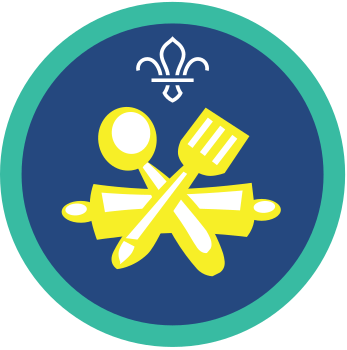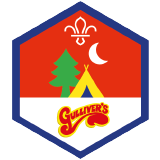
Bake campfire bannock bread
You’ll need
- Ingredients for recipe
- Embers of a campfire
- Mixing bowl
- Access to water
- Mixing spoon
- A cast iron skillet, frying pan or gridiron
- Kitchen foil
- Heatproof gloves
- Heatproof tongs
- Baking tray
- Fire bucket
- A first aid kit, including for burns
- Bowls or plates
- A knife and chopping board
- Items to wash up, such as washing up liquid, sponges and tea towels.
Before you begin
- Use the safety checklist to help you plan and risk assess your activity. There's also more guidance to help you carry out your risk assessment, including examples.
- Make sure you’ll have enough adult helpers. You may need some parents and carers to help if you’re short on helpers.
- Remember to give a safety briefing for the cooking equipment and methods you’re using. You may wish to demonstrate the methods or activity before you all start cooking.
- Check for allergies, intolerances, fasting, food-related medical conditions, eating problems, food sensitivities or dietary requirements, then adjust the food items used as needed. This may include making sure there’s no cross-contamination of packaging and no cross-contamination during the storage, preparation, cooking and serving.
- You may need to use separate chopping boards, equipment and utensils, such as tongs or toasters, for different dietary requirements, allergies and foods.
- If you’re unsure, check with the young person and their parents or carers. You can check with the adult directly if it’s a volunteer or helper.
- Some people may not like certain food textures or tastes and that’s OK. People don’t need to use all the ingredients if they don’t want to, and no-one should be made to try foods if they don’t want to. You can try to find an alternative for them.
- Build and light a fire before starting this activity. Our activities, Campfire admirers or Construct a campfire, can help you to do this. You’ll use the hot embers to cook on, so the fire will need enough time to die down before cooking.
- Make sure the place you choose is safe and accessible for everyone, and that you're able and allowed to build fires there. You may need the landowner’s permission.
- You could run our fire safety activities, Fuel air ignition and Sitting safely by a campfire, prior to running this session.
- If you’re using a kitchen too, you could run our kitchen safety and hygiene activities, Kitchen risk bingo and Home kitchen hygiene prior to running this session.
- Remember to have a hand washing station and take extra hygiene precautions when handling raw meat, such as regular hand washing, having separate equipment for raw and cooked meat, and washing up equipment as soon as it's been used. Look at our guidance on food preparation.
- Make sure you have all the ingredients ready.
- Remember to check your ingredients against any allergy or dietary requirements to ensure everyone can enjoy the recipe. This may mean using alternative ingredients.
- Make sure that everyone’s fires have been built outdoors in clear, open areas, with plenty of ventilation, and away from any areas where people will be sleeping.
- All the fires need to burn down to hot embers before they can start cooking. This increases the chance of the fuel burning without enough oxygen present, increasing the risk of carbon monoxide exposure. We’ve more guidance on different cooking methods.
- If using a gas stove, make sure it’s on a stable heatproof surface and in a clear and open area, with plenty of ventilation.
- You may want to run a fire safety talk or show people how to use the equipment safely.
- Once everyone has finished using the fire, no one should add any more wood. The fire will die down, but make sure it still always has adult supervision.
- Young people should work together to clear up quickly and efficiently – each group needs to wash up their utensils and dispose of rubbish and leftovers.
- An adult should use a new, cold stick (not one that’s been in the fire) to carefully spread out the wood and embers, so they cool down faster.
- An adult should carefully and gently pour water over the smouldering wood and ashes to make sure they’re fully extinguished. They should use the stick to mix the water through the ashes.
- The person leading the activity should make sure the fires are safely extinguished before leaving the site and that everyone has left no trace.
Cook your Bannock bread
Traditional Bannock Bread
Ingredients:
- 200g self-raising flour
- ½ teaspoon salt
- ½ teaspoon baking powder
- ½ cup water
- Cooking oil
- Jam or other toppings (optional)
Fruity Bannock Bread
Ingredients:
- 1 ½ cups of plain flour
- 1 cup of powdered milk
- ½ a teaspoon of baking powder
- ½ a teaspoon of sugar.
- Seasonal fruits or berries
- ½ cup water
For both Bannock Breads:
Prep time: 5 mins
Cook time: 15-25mins
Makes: 1 or 2 breads
- Gather everyone together and explain you’re going to make Bannock Bread.
- Have a fire safety talk or demonstrate how to use the equipment safely, such as for cooking on a campfire or chopping ingredients. Remind everyone to regularly wash their hands, tuck in loose clothing and neckers, and tie long hair back.
- Everyone should get involved in building and lighting a fire. If there’s not enough time to light the fire and let it die down to embers, the person leading the activity could build the fires before everyone else arrives. At least one adult should always be supervising the fire throughout the activity.
- Everyone should wash their hands, then get into smalls groups and gather their ingredients and equipment.
- Make a pile of your dry ingredients in a mixing bowl. Press the back of a spoon into the top of the dry ingredient pile to make a small well or hole.
- Carefully add half a cup of warm water into the well and mix it thoroughly.
- If you’re making the fruity Bannock bread, now’s the time to mix in your seasonal fruits or berries.
- When you’re ready, roll the mixture into one or two balls of dough. Flatten it, either by hand or with a rolling pin, making sure it’s no more than about 2.5cm thick.
- Before cooking, make sure your campfire’s only hot embers and there’s no flame.
- With adult supervision, cook the Bannock bread in one of the following ways, always using heatproof gloves and heatproof tongs:
- Carefully place the dough onto a grid-iron, which is a grate used for cooking on a campfire.
- Put a small amount of oil in a frying pan and let it heat up on the campfire’s embers. Then, carefully place your dough in the pan to cook.
- Brush your dough with a little oil and place it on a piece of kitchen foil.
- If you want to use an oven instead, cook at about 160 degrees Celsius, turning halfway through.
- Cook each side until it’s golden. This should take about 5 to 10 minutes each side on a campfire or 15-20 minutes in an oven.
- An adult should carefully remove the Bannock Bread from the heat, remembering to wear the heatproof gloves and using heatproof tongs.
- The adult should place the bannock bread down on a flat, stable and heatproof surface to cool down, such as a baking tray, making sure it’s out of reach of young people.
- Once it’s cooled, an adult can help to serve the Bannock bread into bowls for tasting. Enjoy your Bannock bread!
Reflection
This activity was a chance to enjoy being outside, and try some traditional methods of cooking.
Did you enjoy cooking outside? How it is different to being inside using an oven?
How does it feel to be using a traditional recipe that Scouts will have been making for over 100 years?
How do you think Scouts will have changed in that time?
Safety
All activities must be safely managed. You must complete a thorough risk assessment and take appropriate steps to reduce risk. Use the safety checklist to help you plan and risk assess your activity. Always get approval for the activity, and have suitable supervision and an InTouch process.
- Cooking
Teach young people how to use cooking equipment safely. Supervise them appropriately throughout. Make sure it’s safe to use and follow manufacturers’ guidelines for use.
- Food
Remember to check for allergies, eating problems, fasting or dietary requirements and adjust the recipe as needed. Make sure you’ve suitable areas for storing and preparing food and avoid cross contamination of different foods. Take a look at our guidance on food safety and hygiene.
- Fires and stoves
Make sure anyone using fires and stoves is doing so safely. Check that the equipment and area are suitable and have plenty of ventilation. Follow the gas safety guidance. Have a safe way to extinguish the fire in an emergency.
- Outdoor activities
You must have permission to use the location. Always check the weather forecast, and inform parents and carers of any change in venue.
- To make it easier, or if you’ll be short on time, you could prepare the ingredients before the session.
- Try making bread without following the recipe. Baden-Powell's instructions involved using the inside of your coat, as a surface to mix and roll your dough. Using just flour, salt, baking powder and hot water (no measurements were given). Then, cooking your dough on either on a gridiron over hot embers, or sweeping part of the fire to one side, placing the dough on the hot ground and piling hot ashes around it.
- If it’s the right time of year, you could pick berries during your camp or hike, to use in the recipe. Make sure you’re aware of the guidelines around picking wild fruit. When you’re picking berries, be certain of what you are picking before you eat it – you might want to make sure you have an experience forager in your team. Only pick fruit from areas where there is plenty, only take the amount that you plan to use, and make sure you leave plenty behind. It’s not just important that other people can enjoy some fruit – you need to leave berries for birds and animals to feed from, and so the plants to reproduce.
- Remember to check your ingredients against any allergy or dietary requirements to ensure everyone can enjoy the recipe. This may mean using alternative ingredients, such as gluten-free flour, which you can find in ‘free from’ sections of supermarkets. If different people are using different ingredients, you may need to avoid cross contamination too.
-
There are lots of different jobs that need doing when you’re cooking. There’s a role for everyone, so encourage everyone to be involved in a way that works for them. Give people the opportunity to work in pairs, or with a young leader or an adult volunteer, if they need some extra support.
-
Some people might not like the feeling of the ingredients or dough on the hands. Provide a spoon for them to use instead, or pair them up with someone if they’d prefer.
All Scout activities should be inclusive and accessible.
Try out some other campfire recipes and use different cooking methods, like cooking on a stick and using a Dutch oven.



